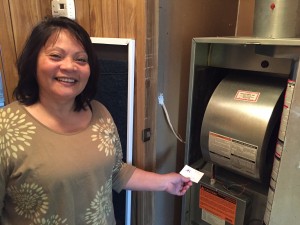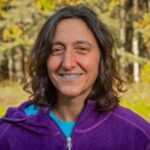Fifty nine-year-old Benita Lozano wants to keep her 37-year-old mobile home warm, so last summer she applied for Anchorage’s Weatherization program through RurAL CAP. The state’s weatherization program began in 1978, during the energy crisis, and continues to help families deal with ever-rising energy costs. RurAL CAP replaced her aging furnace and sealed the areas around her windows, doors, and other places that could leak. And though Lozano was happy, she wanted to make sure the house was air-tight. She taped extra strips of foam to the bottom of her doors to seal the tiniest gap.

“You have a gap in here,” she said pointing to the sliver of space at the bottom of her door. “Did you see this? This is just like the car wiper,” she said pointing to the two inch wide foam strip. “It’s gonna be warm. Because when you close it, it’s gonna close.”
Lozano’s trailer was one of the 375 low-income homes RurAL CAP weatherized in Anchorage this year. That includes houses, trailers, and even apartments. The program focus on seniors, disabled people, and families. Program manager John Simpson said they spend on average $6,000 – $8,000 per unit to make improvements. The average project reduces energy usage by 20 to 30 percent. One of the most common upgrades is air sealing.
“If you have a loose window, door, attic hatch, etc, you have your good warm air escaping out and heating up Alaska for us. That’s a bad thing.”
But 10 to 15 percent of the cost goes towards state-mandated safety improvements, like installing smoke alarms and ventilation systems.
“Some folks don’t realize it but water, moisture from your breath, from your cooking, from your aquariums from your plants, can cause negative effects on your home if you don’t properly ventilate,” Simpson explained.
He added that sealing up ducts can also prevent contaminated air from being pulled into the house.
One of those systems was installed in Lozano’s trailer. She enthusiastically pointed to a label in the bathroom which read “Whole Building Ventilation Control.”
“This is first time that I have in my house.”
A few moments later a fan controlled by a sensor automatically turned on, pulling moisture and contaminants out of the air.
“I really like it,” she said.
Lozano has lived in her three-bedroom home since 2009. She says it used to be filled with dust and cobwebs.
“You see if you move this…” and she banged a roll of toilet paper down on the counter. “You should have dust burst out. But no, you have no dust. That’s why I really believe this is work[ing].”
As her new furnace flipped on, Lozano said she loves the program. “It’s not leaking. Can you see here? It’s warm. And also there are no cobwebs.”
Warm air gushes up from the vents, and Lozano settles into her chair at her kitchen table.
Anne Hillman is the healthy communities editor at Alaska Public Media and a host of Hometown, Alaska. Reach her atahillman@alaskapublic.org. Read more about Annehere.





